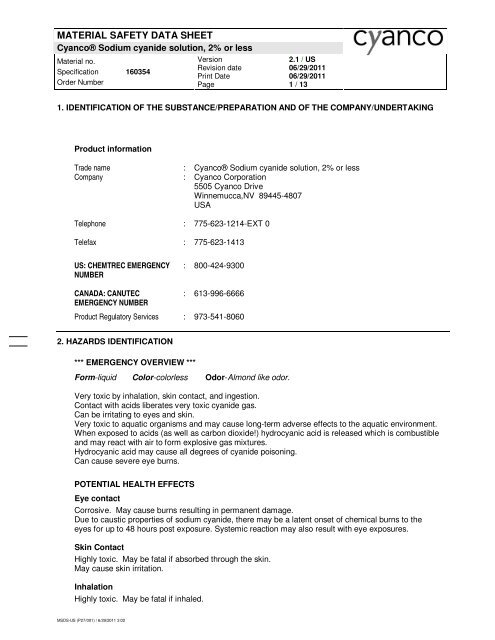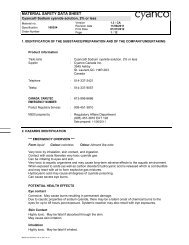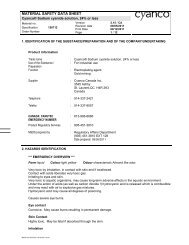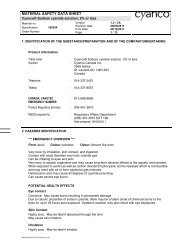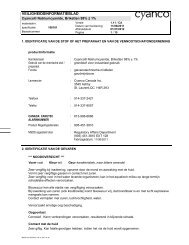Cyanco Sodium cyanide solution, 2 or less US MSDS English
Cyanco Sodium cyanide solution, 2 or less US MSDS English
Cyanco Sodium cyanide solution, 2 or less US MSDS English
You also want an ePaper? Increase the reach of your titles
YUMPU automatically turns print PDFs into web optimized ePapers that Google loves.
MATERIAL SAFETY DATA SHEET<br />
<strong>Cyanco</strong>® <strong>Sodium</strong> <strong>cyanide</strong> <strong>solution</strong>, 2% <strong>or</strong> <strong>less</strong><br />
Material no.<br />
Specification 160354<br />
Order Number<br />
<strong>MSDS</strong>-<strong>US</strong> (P27/001) / 6/29/2011 3:02<br />
Version 2.1 / <strong>US</strong><br />
Revision date 06/29/2011<br />
Print Date 06/29/2011<br />
Page 1 / 13<br />
1. IDENTIFICATION OF THE SUBSTANCE/PREPARATION AND OF THE COMPANY/UNDERTAKING<br />
Product inf<strong>or</strong>mation<br />
Trade name : <strong>Cyanco</strong>® <strong>Sodium</strong> <strong>cyanide</strong> <strong>solution</strong>, 2% <strong>or</strong> <strong>less</strong><br />
Company : <strong>Cyanco</strong> C<strong>or</strong>p<strong>or</strong>ation<br />
5505 <strong>Cyanco</strong> Drive<br />
Winnemucca,NV 89445-4807<br />
<strong>US</strong>A<br />
Telephone : 775-623-1214-EXT 0<br />
Telefax : 775-623-1413<br />
<strong>US</strong>: CHEMTREC EMERGENCY<br />
NUMBER<br />
CANADA: CANUTEC<br />
EMERGENCY NUMBER<br />
: 800-424-9300<br />
: 613-996-6666<br />
Product Regulat<strong>or</strong>y Services : 973-541-8060<br />
2. HAZARDS IDENTIFICATION<br />
*** EMERGENCY OVERVIEW ***<br />
F<strong>or</strong>m-liquid Col<strong>or</strong>-col<strong>or</strong><strong>less</strong> Od<strong>or</strong>-Almond like od<strong>or</strong>.<br />
Very toxic by inhalation, skin contact, and ingestion.<br />
Contact with acids liberates very toxic <strong>cyanide</strong> gas.<br />
Can be irritating to eyes and skin.<br />
Very toxic to aquatic <strong>or</strong>ganisms and may cause long-term adverse effects to the aquatic environment.<br />
When exposed to acids (as well as carbon dioxide!) hydrocyanic acid is released which is combustible<br />
and may react with air to f<strong>or</strong>m explosive gas mixtures.<br />
Hydrocyanic acid may cause all degrees of <strong>cyanide</strong> poisoning.<br />
Can cause severe eye burns.<br />
POTENTIAL HEALTH EFFECTS<br />
Eye contact<br />
C<strong>or</strong>rosive. May cause burns resulting in permanent damage.<br />
Due to caustic properties of sodium <strong>cyanide</strong>, there may be a latent onset of chemical burns to the<br />
eyes f<strong>or</strong> up to 48 hours post exposure. Systemic reaction may also result with eye exposures.<br />
Skin Contact<br />
Highly toxic. May be fatal if abs<strong>or</strong>bed through the skin.<br />
May cause skin irritation.<br />
Inhalation<br />
Highly toxic. May be fatal if inhaled.
MATERIAL SAFETY DATA SHEET<br />
<strong>Cyanco</strong>® <strong>Sodium</strong> <strong>cyanide</strong> <strong>solution</strong>, 2% <strong>or</strong> <strong>less</strong><br />
Material no.<br />
Specification 160354<br />
Order Number<br />
May cause irritations of the respirat<strong>or</strong>y tract.<br />
Ingestion<br />
Highly toxic. May be fatal if swallowed.<br />
Potential environmental effect<br />
<strong>MSDS</strong>-<strong>US</strong> (P27/001) / 6/29/2011 3:02<br />
Version 2.1 / <strong>US</strong><br />
Revision date 06/29/2011<br />
Print Date 06/29/2011<br />
Page 2 / 13<br />
Very toxic to aquatic <strong>or</strong>ganisms; may cause long-term adverse effects in the aquatic environment.<br />
3. COMPOSITION/INFORMATION ON INGREDIENTS<br />
Chemical nature<br />
Solution in water.<br />
Inf<strong>or</strong>mation on ingredients / Hazardous components<br />
<strong>Sodium</strong> <strong>cyanide</strong><br />
CAS-No. 143-33-9 Percent (Wt./ Wt.)
MATERIAL SAFETY DATA SHEET<br />
<strong>Cyanco</strong>® <strong>Sodium</strong> <strong>cyanide</strong> <strong>solution</strong>, 2% <strong>or</strong> <strong>less</strong><br />
Material no.<br />
Specification 160354<br />
Order Number<br />
<strong>MSDS</strong>-<strong>US</strong> (P27/001) / 6/29/2011 3:02<br />
Version 2.1 / <strong>US</strong><br />
Revision date 06/29/2011<br />
Print Date 06/29/2011<br />
Page 3 / 13<br />
Immediately contact the emergency doct<strong>or</strong> immediately (alarm rep<strong>or</strong>t: <strong>cyanide</strong> / hydrocyanic acid<br />
poisoning).<br />
Skin contact<br />
No cases of <strong>cyanide</strong> intoxication have been observed to date following contact with dry sodium <strong>or</strong><br />
potassium <strong>cyanide</strong> on dry skin free of injuries. However, if the dry sodium <strong>or</strong> potassium <strong>cyanide</strong> comes<br />
in contact with moisture <strong>or</strong> acids, then hydrogen <strong>cyanide</strong> may be released, causing <strong>cyanide</strong> intoxication.<br />
Wash off immediately using large amounts of water (and soap if available) while removing all<br />
contaminated clothes and shoes.<br />
Immediately contact <strong>or</strong> summon an emergency physician immediately in case of intoxication symptoms<br />
(key terms: intoxication with <strong>cyanide</strong> / prussic acid).<br />
Eye contact<br />
In case of contact with the eyes, immediately flush eyes with copious amounts of water f<strong>or</strong> a minimum of<br />
15 minutes while removing clothes. It is imp<strong>or</strong>tant to seek medical attention f<strong>or</strong> all eye exposures due to<br />
potential caustic burns of the eyes.<br />
Immediately contact <strong>or</strong> summon an emergency physician in case of intoxication symptoms (key terms:<br />
intoxication with <strong>cyanide</strong> / prussic acid).<br />
An ophthalmologist should also be consulted f<strong>or</strong> evaluation of caustic burns to the eyes. Eye burns may<br />
not be apparent f<strong>or</strong> up to 48 hours post exposure due to the caustic properties of sodium <strong>cyanide</strong>.<br />
Ingestion<br />
Th<strong>or</strong>oughly rinse mouth with water.<br />
Seek professional medical care immediately.<br />
Do not induce vomiting<br />
Call emergency doct<strong>or</strong> immediately (alarm rep<strong>or</strong>t: <strong>cyanide</strong> / hydro-cyanic acid poisoning ).<br />
Immediately transp<strong>or</strong>t to a medical facility.<br />
Notes to physician<br />
IMPORTANT: Specific antidote and treatment may vary by region. If you are not familiar with current<br />
treatment recommendations, you should contact the Poison Control Center f<strong>or</strong> your region <strong>or</strong> country f<strong>or</strong><br />
specific recommendations and guidelines.<br />
Possible signs of poisoning:<br />
Intoxication is classified by 2 categ<strong>or</strong>ies:<br />
Mild poisoning<br />
Severe poisoning<br />
The following symptoms are not sufficient to ensure a c<strong>or</strong>rect diagnosis:<br />
Symptoms of the central nervous system:<br />
Early stage: headache, dizziness, somnolence (drowsiness), nausea.<br />
Advanced stage: seizures, coma.<br />
Pulmonary symptoms:<br />
Early stage: dyspnea, tachypnea.<br />
Advanced stage: hyperventilation, Cheyne-Stokes respiration, apnea.<br />
Cardiovascular symptoms:<br />
Early stage<br />
hypertension, sinus arrhythmia, atrioventricular arrhythmia, bradycardia.<br />
Advanced stage: tachycardia, complex arrhythmia, cardiac arrest.<br />
Skin symptoms:<br />
Early stage: rosy skin col<strong>or</strong>.<br />
Advanced stage: cyanosis.<br />
Effect on the metabolism:<br />
Lactate acidosis: pH 7.1 and lactate level of 17 mmol/l are described.<br />
Treatment:
MATERIAL SAFETY DATA SHEET<br />
<strong>Cyanco</strong>® <strong>Sodium</strong> <strong>cyanide</strong> <strong>solution</strong>, 2% <strong>or</strong> <strong>less</strong><br />
Material no.<br />
Specification 160354<br />
Order Number<br />
<strong>MSDS</strong>-<strong>US</strong> (P27/001) / 6/29/2011 3:02<br />
Version 2.1 / <strong>US</strong><br />
Revision date 06/29/2011<br />
Print Date 06/29/2011<br />
Page 4 / 13<br />
NOTE: The treatment advice may vary by region. See Material Safety Data Sheet <strong>or</strong> contact regional<br />
poison control center f<strong>or</strong> appropriate antidote treatment used in your region.<br />
The rescuer <strong>or</strong> medical responder should first of all protect themselves from exposure.<br />
Decontaminate the victim to prevent further abs<strong>or</strong>ption and exposure to rescuers. Monit<strong>or</strong> vital signs.<br />
Rapid treatment with appropriate antidote therapy is essential to saving lives during a high dose acute<br />
exposure to <strong>cyanide</strong>. NOTE: removal of toxic substance has equal imp<strong>or</strong>tance to implementation of<br />
antidote therapy.<br />
NOTE: This is an outline of antidotes available f<strong>or</strong> inf<strong>or</strong>mational purposes. It is imp<strong>or</strong>tant f<strong>or</strong> the treating<br />
physician to be familiar with the administration of <strong>cyanide</strong> antidotes available in the country where the<br />
chemical is being used!<br />
Mild poisoning<br />
Treatment is dependant on clinical presentation with symptoms and hist<strong>or</strong>y of exposure (related to<br />
dose).<br />
100% oxygen and artificial respiration if indicated.<br />
Closely monit<strong>or</strong> patient and their vital signs (Blood pressure, pulse and respirations).<br />
Monit<strong>or</strong> the patient f<strong>or</strong> onset of symptoms <strong>or</strong> deteri<strong>or</strong>ation of status.<br />
Depending on the pathology and clinical findings, based on strictly monit<strong>or</strong>ed controls of the clinical<br />
findings, it may be necessary f<strong>or</strong> the physician to implement symptom-<strong>or</strong>iented treatment f<strong>or</strong> pulmonary<br />
edema prophylaxis. X-rays of the lungs may be necessary f<strong>or</strong> pulmonary edema diagnosis.<br />
Specific antidote treatment can be indicated f<strong>or</strong> moderate to severe <strong>cyanide</strong> intoxication: (It is imp<strong>or</strong>tant<br />
to know that there are several different types of antidotes available f<strong>or</strong> treatment of <strong>cyanide</strong> intoxication<br />
in different countries) If the treating physician is not familiar with <strong>cyanide</strong> exposure and treatment, they<br />
should contact the medical division of their regional poison control centers f<strong>or</strong> immediate assistance with<br />
additional inf<strong>or</strong>mation as needed.<br />
F<strong>or</strong> all <strong>cyanide</strong> exposure:<br />
All <strong>cyanide</strong> exposed persons should undergo continued monit<strong>or</strong>ing f<strong>or</strong> several hours, even if patient<br />
feels well to ensure there are no residual <strong>or</strong> recurrent poisoning symptoms.<br />
Severe poisoning<br />
Artificial respiration with 100% oxygen.<br />
Immediate antidote administration with the legal antidote f<strong>or</strong> the country of the exposure.<br />
Listed below are the two most commonly used antidotes:<br />
1. Methemoglobin-f<strong>or</strong>ming agent<br />
Nitrite Therapy: (amyl nitrite, sodium nitrite and sodium thiosulfate) (commonly referred to as the Tayl<strong>or</strong>,<br />
Lilly <strong>or</strong> Pasadena Cyanide Antidote Kit).<br />
F<strong>or</strong> moderate to severe exposures (patient still conscious)<br />
Amyl Nitrite Aspirols: (1-3 aspirols administered as an inhalant, held 1 -2 inches under the nose f<strong>or</strong> 15-<br />
30 seconds, and then remove f<strong>or</strong> 15-30 seconds) (read medication inf<strong>or</strong>mation insert pri<strong>or</strong> to<br />
administering).<br />
<strong>Sodium</strong> nitrite 300 - 600 mg administered intravenously over a period of 5 to 15 minutes.<br />
<strong>Sodium</strong> Thiosulfate (12.5 g - 100-500 mg/kg weight) intravenously over a period of 15-20 minutes.<br />
If patient is conscious, then sodium Thiosulfate may be administered as an antidote by itself: (see<br />
antidote package inf<strong>or</strong>mation insert)<br />
<strong>Sodium</strong> Thiosulfate (12.5 g - 100-500 mg/kg weight) IV may be administered depending on the clinical<br />
presentation and symptoms.<br />
2. Complexing antidote agent: Hydroxycobalamin (commonly known as the Cyanokit)<br />
Treatment as follows:<br />
Administer hydroxocobalamin (Cyanokit®) 5 g i.v. (70 mg/kg b.w. in adults) by infusion over a period of<br />
20 - 30 minutes. Administration of this dose can be repeated as required depending on the severity of<br />
poisoning. Infusion time f<strong>or</strong> repeated dose: 30 minutes to 2 hours. The only permissible route of<br />
administration f<strong>or</strong> hydroxocobalamine is intravenously. (The physician should read the medication<br />
package inf<strong>or</strong>mation carefully to ensure proper reconstitution to liquid state and administration of<br />
antidote!).
MATERIAL SAFETY DATA SHEET<br />
<strong>Cyanco</strong>® <strong>Sodium</strong> <strong>cyanide</strong> <strong>solution</strong>, 2% <strong>or</strong> <strong>less</strong><br />
Material no.<br />
Specification 160354<br />
Order Number<br />
5. FIRE-FIGHTING MEASURES<br />
<strong>MSDS</strong>-<strong>US</strong> (P27/001) / 6/29/2011 3:02<br />
Version 2.1 / <strong>US</strong><br />
Revision date 06/29/2011<br />
Print Date 06/29/2011<br />
Page 5 / 13<br />
Flash point Not combustible.<br />
Lower explosion limit not applicable<br />
Upper explosion limit not applicable<br />
Autoignition temperature not applicable<br />
Suitable extinguishing media<br />
quenching powder<br />
In case of fire in the surroundings:, alkali powder quenching agent<br />
Extinguishing media which must not be used f<strong>or</strong> safety reasons<br />
carbon dioxide (CO2)<br />
Specific hazards during fire fighting<br />
May be released in case of fire: Hydro-cyanic acid<br />
Special protective equipment f<strong>or</strong> fire-fighters<br />
As in any fire, wear self-contained positive-pressure breathing apparatus, (MSHA/NIOSH approved <strong>or</strong><br />
equivalent) and full protective gear.<br />
Further inf<strong>or</strong>mation<br />
Standard procedure f<strong>or</strong> chemical fires. Ensure there are sufficient retaining facilities f<strong>or</strong> water used to<br />
extinguish fire. Water used to extinguish fire should not enter drainage systems, soil <strong>or</strong> stretches of<br />
water. Contaminated fire-extinguishing water must be disposed of in acc<strong>or</strong>dance with the regulations<br />
issued by the appropriate local auth<strong>or</strong>ities. Fire residues should be disposed of in acc<strong>or</strong>dance with the<br />
regulations.<br />
6. ACCIDENTAL RELEASE MEASURES<br />
Personal precautions<br />
Wear personal protective equipment.<br />
Keep out unprotected persons.<br />
Keep unauth<strong>or</strong>ized persons away.<br />
Ensure sufficient ventilation. Avoid skin contact because of the danger of skin abs<strong>or</strong>ption.<br />
Make safe <strong>or</strong> remove all sources of ignition.<br />
Environmental precautions<br />
Do not allow entrance in soil, stretches of water, groundwater, drainage systems, surface water.<br />
Cyanide-containing sewage water and <strong>solution</strong>s must be decontaminated bef<strong>or</strong>e entering a public canal<br />
netw<strong>or</strong>k <strong>or</strong> stretch of water.<br />
Methods f<strong>or</strong> cleaning up<br />
Abs<strong>or</strong>b with liquid-binding material e.g. inert abs<strong>or</strong>bent
MATERIAL SAFETY DATA SHEET<br />
<strong>Cyanco</strong>® <strong>Sodium</strong> <strong>cyanide</strong> <strong>solution</strong>, 2% <strong>or</strong> <strong>less</strong><br />
Material no.<br />
Specification 160354<br />
Order Number<br />
Pick up mechanically. Collect in suitable containers.<br />
<strong>MSDS</strong>-<strong>US</strong> (P27/001) / 6/29/2011 3:02<br />
Version 2.1 / <strong>US</strong><br />
Revision date 06/29/2011<br />
Print Date 06/29/2011<br />
Page 6 / 13<br />
Dispose of abs<strong>or</strong>bed material in acc<strong>or</strong>dance with the regulations.<br />
Waste to be packed like clean product and to be marked. Identification label on packages not to be<br />
removed until recycling.<br />
Additional advice<br />
On contact with acid, hydrogen <strong>cyanide</strong> is produced.<br />
7. HANDLING AND STORAGE<br />
Handling<br />
Safe handling advice<br />
Container may be opened only under exhaust ventilation hood.<br />
Seal container hermetically immediately after use.<br />
St<strong>or</strong>e under lock and key <strong>or</strong> in a way that only skilled persons have access to it.<br />
Be careful when opening the package, since toxic and caustic gases and vapours may escape.<br />
Advice on protection against fire and explosion<br />
The product is not combustible.<br />
see section 5.<br />
St<strong>or</strong>age<br />
Requirements f<strong>or</strong> st<strong>or</strong>age areas and containers<br />
Keep container tightly sealed and st<strong>or</strong>e in a dry, well-ventilated place.<br />
clean, dry, lockable.<br />
Ensure there are sufficient retaining facilities f<strong>or</strong> water used to extinguish fire.<br />
Unsuitable materials aluminium<br />
Advice on common st<strong>or</strong>age<br />
Do not st<strong>or</strong>e together with: acid and acidic salts.<br />
Keep away from food, drink and animal feedingstuffs.<br />
8. EXPOSURE CONTROLS / PERSONAL PROTECTION<br />
Component occupational exposure guidelines<br />
• Hydrogen <strong>cyanide</strong><br />
CAS-No. 74-90-8<br />
Control parameters 4.7 ppm as CN Ceiling Limit Value:(ACGIH)<br />
as CN Skin designation:(ACGIH)<br />
Can be abs<strong>or</strong>bed through the skin.<br />
10 ppm<br />
11 mg/m3<br />
Can be abs<strong>or</strong>bed through the skin.<br />
4.7 ppm<br />
5 mg/m3<br />
PEL:(OSHA Z1)<br />
Skin designation:(OSHA Z1)<br />
Ceiling Limit Value:(<strong>US</strong> CA OEL)
MATERIAL SAFETY DATA SHEET<br />
<strong>Cyanco</strong>® <strong>Sodium</strong> <strong>cyanide</strong> <strong>solution</strong>, 2% <strong>or</strong> <strong>less</strong><br />
Material no.<br />
Specification 160354<br />
Order Number<br />
• <strong>Sodium</strong> <strong>cyanide</strong><br />
<strong>MSDS</strong>-<strong>US</strong> (P27/001) / 6/29/2011 3:02<br />
Version 2.1 / <strong>US</strong><br />
Revision date 06/29/2011<br />
Print Date 06/29/2011<br />
Page 7 / 13<br />
Can be abs<strong>or</strong>bed through the skin.<br />
Skin designation:(<strong>US</strong> CA OEL)<br />
CAS-No. 143-33-9<br />
5 mg/m3 as CN PEL:(OSHA Z1)<br />
as CN Skin designation:(OSHA Z1)<br />
Can be abs<strong>or</strong>bed through the skin.<br />
Other inf<strong>or</strong>mation<br />
Suitable measuring processes are:<br />
Hydro-cyanic acid<br />
OSHA method ID 120<br />
Engineering measures<br />
5 mg/m3 as CN Ceiling Limit Value:(ACGIH)<br />
as CN Skin designation:(ACGIH)<br />
Can be abs<strong>or</strong>bed through the skin.<br />
5 mg/m3 as CN Time Weighted Average (TWA)<br />
Permissible Exposure Limit (PEL):(<strong>US</strong> CA<br />
OEL)<br />
as CN Skin designation:(<strong>US</strong> CA OEL)<br />
Can be abs<strong>or</strong>bed through the skin.<br />
Engineer out the risk of exposure.<br />
Ensure suitable suction/aeration at the w<strong>or</strong>k place and with operational machinery.<br />
Personal protective equipment<br />
Respirat<strong>or</strong>y protection<br />
A respirat<strong>or</strong>y protection program that meets OSHA 1910.134 and ANSI Z88.2 <strong>or</strong> applicable<br />
federal/provincial requirements must be followed whenever w<strong>or</strong>kplace conditions warrant respirat<strong>or</strong> use.<br />
NIOSH's "Respirat<strong>or</strong> Decision Logic" may be useful in determining the suitability of various types of<br />
respirat<strong>or</strong>s.<br />
Hand protection<br />
Glove material Natural rubber (NR)<br />
Material thickness 0.5 mm<br />
Break through time >= 480 min<br />
Method DIN EN 374<br />
Glove material Nitrile<br />
Material thickness 0.11 mm<br />
Break through time >= 480 min<br />
Method DIN EN 374<br />
Glove material Nitrile<br />
Material thickness 0.33 mm<br />
Break through time >= 480 min<br />
Method DIN EN 374<br />
Glove material Polychl<strong>or</strong>oprene with natural-latex liner.
MATERIAL SAFETY DATA SHEET<br />
<strong>Cyanco</strong>® <strong>Sodium</strong> <strong>cyanide</strong> <strong>solution</strong>, 2% <strong>or</strong> <strong>less</strong><br />
Material no.<br />
Specification 160354<br />
Order Number<br />
Material thickness 0.6 mm<br />
Break through time >= 480 min<br />
Method DIN EN 374<br />
Glove material PVC gloves<br />
<strong>MSDS</strong>-<strong>US</strong> (P27/001) / 6/29/2011 3:02<br />
Version 2.1 / <strong>US</strong><br />
Revision date 06/29/2011<br />
Print Date 06/29/2011<br />
Page 8 / 13<br />
The above mentioned hand protection is based on knowledge of the chemistry and anticipated uses of<br />
this product but it may not be appropriate f<strong>or</strong> all w<strong>or</strong>kplaces. A hazard assessment should be conducted<br />
pri<strong>or</strong> to use to ensure suitability of gloves f<strong>or</strong> specific w<strong>or</strong>k environments and processes pri<strong>or</strong> to use.<br />
Eye protection<br />
goggles<br />
face-shield<br />
Skin and body protection<br />
chemical protective suit<br />
During cleaning w<strong>or</strong>k: rubber <strong>or</strong> plastic boots.<br />
To identify additional Personal Protective Equipment (PPE) requirements, it is recommended that a<br />
hazard assessment in acc<strong>or</strong>dance with the OSHA PPE Standard (29CFR1910.132) be conducted bef<strong>or</strong>e<br />
using this product.<br />
A safety shower and eye wash fountain must be readily available.<br />
Hygiene measures<br />
Avoid contact with skin.<br />
After contact with skin, wash immediately with plenty of water.<br />
No eating, drinking, smoking, <strong>or</strong> snuffing tobacco at w<strong>or</strong>k. Wash face and/<strong>or</strong> hands bef<strong>or</strong>e break and end<br />
of w<strong>or</strong>k.<br />
preventive skin protection<br />
Keep w<strong>or</strong>king clothes separately.<br />
Avoid contaminating clothes with product.<br />
Immediately change moistened and saturated w<strong>or</strong>k clothes.<br />
Immediately rinse contaminated <strong>or</strong> saturated clothing with water.<br />
Protective measures<br />
All precautionary measures indicated have to be observed.<br />
The w<strong>or</strong>k-place related airb<strong>or</strong>ne concentrations have to be kept below of the indicated exposure limits.<br />
If w<strong>or</strong>kplace exposure limits are exceeded and/<strong>or</strong> larger amounts are released (leakage, spilling, dust)<br />
the indicated respirat<strong>or</strong>y protection should be used.<br />
9. PHYSICAL AND CHEMICAL PROPERTIES<br />
Appearance<br />
F<strong>or</strong>m liquid<br />
Col<strong>or</strong> col<strong>or</strong><strong>less</strong><br />
Od<strong>or</strong> Almond like od<strong>or</strong>.<br />
Safety data<br />
Melting point/range ca. 0 °C<br />
Boiling point/range ca. 100 °C<br />
Flash point Not combustible.
MATERIAL SAFETY DATA SHEET<br />
<strong>Cyanco</strong>® <strong>Sodium</strong> <strong>cyanide</strong> <strong>solution</strong>, 2% <strong>or</strong> <strong>less</strong><br />
Material no.<br />
Specification 160354<br />
Order Number<br />
Flammability not applicable<br />
Autoignition temperature: not applicable<br />
Autoinflammability not applicable<br />
Lower explosion limit not applicable<br />
Upper explosion limit not applicable<br />
maximum absolute explosive<br />
pressure<br />
not applicable<br />
Vap<strong>or</strong> pressure 14.7 hPa (20 °C)<br />
<strong>MSDS</strong>-<strong>US</strong> (P27/001) / 6/29/2011 3:02<br />
Version 2.1 / <strong>US</strong><br />
Revision date 06/29/2011<br />
Print Date 06/29/2011<br />
Page 9 / 13<br />
Density ca. 1.0 g/cm3 (20 °C)<br />
Bulk density not applicable<br />
Partition coefficient (n-octanol/water) not investigated<br />
Viscosity, dynamic not applicable<br />
Viscosity, kinematic not applicable<br />
Further inf<strong>or</strong>mation<br />
Miscibility in water completely miscible<br />
10. STABILITY AND REACTIVITY<br />
Materials to avoid Under the action of acids (as well as carbon dioxide !) hydrocyanic acid is<br />
released which is combustible and may react with air to explosive gas<br />
mixtures., Keep away from acidic salts.<br />
Hazardous decomposition products HCN: Hydrogen <strong>cyanide</strong> (hydrocyanic acid)<br />
11. TOXICOLOGICAL INFORMATION<br />
Product Acute <strong>or</strong>al toxicity LD50 Rat: 258 mg/kg<br />
(calculated)<br />
Product Acute dermal toxicity LD50 Rabbit: 416 mg/kg<br />
Product Human experience Very toxic by inhalation and if swallowed.<br />
Inhaling of (at already approx. 200 ppm HCN in the air breathed) <strong>or</strong><br />
swallowing (approx. 200 - 300 mg KCN) can result in immediate<br />
unconsciousness and death.<br />
Can be abs<strong>or</strong>bed through the skin.
MATERIAL SAFETY DATA SHEET<br />
<strong>Cyanco</strong>® <strong>Sodium</strong> <strong>cyanide</strong> <strong>solution</strong>, 2% <strong>or</strong> <strong>less</strong><br />
Material no.<br />
Specification 160354<br />
Order Number<br />
12. ECOLOGICAL INFORMATION<br />
Ecotoxicity effects<br />
<strong>MSDS</strong>-<strong>US</strong> (P27/001) / 6/29/2011 3:02<br />
Version 2.1 / <strong>US</strong><br />
Revision date 06/29/2011<br />
Print Date 06/29/2011<br />
Page 10 / 13<br />
Poisoning has an effect on the central nervous system.<br />
Irritating to eyes, respirat<strong>or</strong>y system and skin.<br />
Toxicity to fish LC50 Leuciscus idus melanotus: 0.07 mg/l<br />
Test substance: solid product<br />
Method: literature<br />
related to substance: <strong>Sodium</strong> <strong>cyanide</strong><br />
Toxicity to daphnia EC50 Daphnia magna: 0.3 mg/l<br />
Test substance: solid product<br />
Method: literature<br />
related to substance: <strong>Sodium</strong> <strong>cyanide</strong><br />
Toxicity to bacteria EC50 Escherichia coli: 0.004 mg/l<br />
Test substance: solid product<br />
Method: literature<br />
related to substance: <strong>Sodium</strong> <strong>cyanide</strong><br />
13. DISPOSAL CONSIDERATIONS<br />
WASTE DISPOSAL<br />
Advice on disposal Waste must be disposed of in acc<strong>or</strong>dance with local, state, provincial and<br />
federal laws and regulations. Empty containers must be handled with care<br />
due to product residue.<br />
14. TRANSPORT INFORMATION<br />
D.O.T. Road/Rail<br />
Class 6.1<br />
UN-No 3414<br />
Packing group I<br />
Proper shipping name SODIUM CYANIDE SOLUTION<br />
Marine pollutant Marine pollutant<br />
Sea transp<strong>or</strong>t IMDG-Code<br />
Class 6.1<br />
UN-No 3414<br />
Packaging group I<br />
Marine pollutant Marine pollutant<br />
EmS F-A, S-A<br />
Proper technical name (Proper shipping name)<br />
SODIUM CYANIDE SOLUTION
MATERIAL SAFETY DATA SHEET<br />
<strong>Cyanco</strong>® <strong>Sodium</strong> <strong>cyanide</strong> <strong>solution</strong>, 2% <strong>or</strong> <strong>less</strong><br />
Material no.<br />
Specification 160354<br />
Order Number<br />
<strong>MSDS</strong>-<strong>US</strong> (P27/001) / 6/29/2011 3:02<br />
Version 2.1 / <strong>US</strong><br />
Revision date 06/29/2011<br />
Print Date 06/29/2011<br />
Page 11 / 13<br />
Marine pollutant Marine pollutant<br />
Air transp<strong>or</strong>t ICAO-TI/IATA-DGR<br />
Class 6.1<br />
UN-No 3414<br />
Packaging group I<br />
Proper technical name (Proper shipping name)<br />
<strong>Sodium</strong> <strong>cyanide</strong> <strong>solution</strong><br />
Loading instructions/Remarks<br />
IATA_C ERG-Code 6L<br />
IATA_P ERG-Code 6L<br />
IMDG Do not stow in external container rows<br />
Transp<strong>or</strong>t/further inf<strong>or</strong>mation<br />
Do not st<strong>or</strong>e together with acids (danger of toxic gases) <strong>or</strong> with foodstuffs, consumables and<br />
feedstuffs.<br />
15. REGULATORY INFORMATION<br />
Inf<strong>or</strong>mation on ingredients / Non-hazardous components<br />
This product contains the following non-hazardous components<br />
Water<br />
<strong>US</strong> Federal Regulations<br />
OSHA<br />
CAS-No. 7732-18-5 Percent (Wt./ Wt.) > 98 %<br />
If listed below, chemical specific standards apply to the product <strong>or</strong> components:<br />
• None listed<br />
Clean Air Act Section (112)<br />
If listed below, components present at <strong>or</strong> above the de minimus level are hazardous air pollutants:<br />
• <strong>Sodium</strong> <strong>cyanide</strong><br />
CAS-No. 143-33-9<br />
CERCLA Rep<strong>or</strong>table Quantities<br />
If listed below, a rep<strong>or</strong>table quantity (RQ) applies to the product based on the percent of the named<br />
component:<br />
• <strong>Sodium</strong> <strong>cyanide</strong><br />
CAS-No. 143-33-9<br />
Rep<strong>or</strong>table Quantity 500 lbs
MATERIAL SAFETY DATA SHEET<br />
<strong>Cyanco</strong>® <strong>Sodium</strong> <strong>cyanide</strong> <strong>solution</strong>, 2% <strong>or</strong> <strong>less</strong><br />
Material no.<br />
Specification 160354<br />
Order Number<br />
<strong>MSDS</strong>-<strong>US</strong> (P27/001) / 6/29/2011 3:02<br />
Version 2.1 / <strong>US</strong><br />
Revision date 06/29/2011<br />
Print Date 06/29/2011<br />
Page 12 / 13<br />
SARA Title III Section 311/312 Hazard Categ<strong>or</strong>ies<br />
The product meets the criteria only f<strong>or</strong> the listed hazard classes:<br />
• Acute Health Hazard<br />
SARA Title III Section 313 Rep<strong>or</strong>table Substances<br />
If listed below, components are subject to the rep<strong>or</strong>ting requirements of Section 313 of Title III of the<br />
Superfund Amendments and Reauth<strong>or</strong>ization Act of 1986 and 40 CFR Part 372:<br />
• <strong>Sodium</strong> <strong>cyanide</strong><br />
CAS-No. 143-33-9<br />
Toxic Substances Control Act (TSCA)<br />
If listed below, non-proprietary substances are subject to exp<strong>or</strong>t notification under Section 12 (b) of<br />
TSCA:<br />
• None listed<br />
State Regulations<br />
Calif<strong>or</strong>nia Proposition 65<br />
A warning under the Calif<strong>or</strong>nia Drinking Water Act is required only if listed below:<br />
• None listed<br />
International Chemical Invent<strong>or</strong>y Status<br />
Un<strong>less</strong> otherwise noted, this product is in compliance with the invent<strong>or</strong>y listing of the countries shown<br />
below. F<strong>or</strong> inf<strong>or</strong>mation on listing f<strong>or</strong> countries not shown, contact the Product Regulat<strong>or</strong>y Services<br />
Department.<br />
• Europe (EINECS/ELINCS) Listed/registered<br />
• <strong>US</strong>A (TSCA) Listed/registered<br />
• Canada (DSL) Listed/registered<br />
• Australia (AICS) Listed/registered<br />
• Japan (MITI) Listed/registered<br />
• K<strong>or</strong>ea (TCCL) Listed/registered<br />
• Philippines (PICCS) Listed/registered<br />
• China Listed/registered<br />
• New Zealand Listed/registered<br />
16. OTHER INFORMATION<br />
HMIS Ratings<br />
Health : 3
MATERIAL SAFETY DATA SHEET<br />
<strong>Cyanco</strong>® <strong>Sodium</strong> <strong>cyanide</strong> <strong>solution</strong>, 2% <strong>or</strong> <strong>less</strong><br />
Material no.<br />
Specification 160354<br />
Order Number<br />
Further inf<strong>or</strong>mation<br />
<strong>MSDS</strong>-<strong>US</strong> (P27/001) / 6/29/2011 3:02<br />
Flammability : 0<br />
Physical Hazard : 1<br />
Version 2.1 / <strong>US</strong><br />
Revision date 06/29/2011<br />
Print Date 06/29/2011<br />
Page 13 / 13<br />
Changes since the last version are highlighted in the margin. This version replaces all previous versions.<br />
The inf<strong>or</strong>mation provided in this Safety Data Sheet is c<strong>or</strong>rect to the best of our knowledge, inf<strong>or</strong>mation<br />
and belief at the date of its publication. The inf<strong>or</strong>mation given is designed only as a guidance f<strong>or</strong> safe<br />
handling, use, processing, st<strong>or</strong>age, transp<strong>or</strong>tation, disposal and release and is not to be considered a<br />
warranty <strong>or</strong> quality specification. The inf<strong>or</strong>mation relates only to the specific material designated and<br />
may not be valid f<strong>or</strong> such material used in combination with any other materials <strong>or</strong> in any process, un<strong>less</strong><br />
specified in the text.


